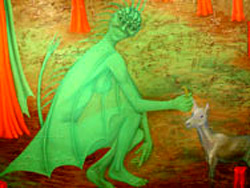 |
 |
 |
 Vallarta Living | Art Talk | March 2006 Vallarta Living | Art Talk | March 2006  
Texas' Blood-Sucking Monster
 Joy Victory - ABC News Joy Victory - ABC News


| | "The Harvest" by artist Carlos Gomez features El Chupacabra, a monster rumored to feed on livestock along the U.S.-Mexico border. Gomez recently created a series of works about the creature. (Carlos G. Gomez) |
In south Texas, its frightening name resurfaces in the news every few months - especially after another neighborhood pet or farm animal mysteriously dies.

"El Chupacabra," they say, "is back."

Parents are cautious, warning their children to stay inside at night or risk a face-to-fang encounter with the chupacabra - a red-eyed, spiky-haired, blood-sucking creature with a green-blue tint to its hide.

The chupacabra haunts the minds of the residents in La Frontera, the U.S.-Mexico borderlands. Here, an amalgamation of cultures blend, represented by Gulf shrimp tacos, polka-inspired Tejano music, and young, white girls who also hold quinceneras, the Mexican teen rite-of-passage celebration.

Amid this mostly peaceful cultural mishmash, the chupacabra - translates to goat-sucker - replaces the boogeyman. Rumored to be originally of Puerto Rican folklore, the chupacabra and its reign spread to Central America in the '80s and '90s, and has moved northward through Mexico and Texas, where it has quickly been embraced and has lately been portrayed in artwork and film.

Is It Real?

Like other mythic monsters, the chupacabra has its believers - just ask www.elchupacabra.com Webmaster and science-fiction buff Dave Pettis.

"I just believe there can be something out there like that," said Pettis, who lives in Northern California. "I don't think every animal in the world has been classified."

Pettis said he gets lots of e-mails from people. Some are curious about the creature, while others want to submit their own sightings.

"Some people think it's some [lab] experiment that escaped, but other people think it's some animal that's been around for a long time, like in South America. The clearing of the rain forests has made it come out," he said.

The Mexican Boogeyman

It's these sorts of theories that make anthropologist Tony Zavaleta chuckle. He loves the chupacabra myth, but it's for different reasons. It's simply a great part of Mexican-American folklore, he said. While the chupacabra is by far the most popular myth, it is just one of several indigenous monsterlike creatures. There's also El Cucuy, or a small humanlike demon that also goes after kids at night.

"It's so universal. … Every group of people, regardless of where they are, they have what I define or describe as the boogeyman - the story you use to keep children in line and inside at night," said Zavaleta, a professor and vice president for external affairs at the University of Texas at Brownsville.

Zavaleta's favorite encounter with the chupacabra came while walking through Mexico City a few years ago. He spotted a mask for sale - one that looked partly like a chupacabra and partly like the Mexico president at that time. He had to laugh.

"It's the metaphor for the evil president: the blood sucker," he said.

The Whimsical Monster

High in the mountains of northern Mexico, not far from the Texas border, many of the farmers do not laugh about the chupacabra, said artist and fellow Texas professor Carlos Gomez. There, the chupacabra is blamed for killing cattle and other livestock.

While traveling around the El Cielo cloud forest a few years ago, he tried to joke with the locals about the blood-sucking monster.

He received a cool response.

"There had been some sightings. People were panicking," he said. "Their livestock is their livelihood. They really depend on that."

His trip inspired him to create a recent set of paintings about the chupacabra. Instead of portraying it as a monster, he took a whimsical approach, defying local perceptions.

"Some are old. Some are young and showboating," he said. "Some are blue with red moles, or red with freckles."

A Cult Favorite

Henry Serrato, who works for a south Texas television station and is an amateur filmmaker, also took a whimsical approach with his mockumentary or documentary spoof titled "The Search for the Chupacabra."

Blending real in-person interviews with fictionalized accounts, his film highlights some of the absurdities of the science-fiction fan world - such as the time a real film crew showed up in south Texas ready to film scenes about sightings of a giant Pterodactyl-like bird last spotted there in the '70s.

"The crew shows up in 1996 - 20 years too late. Here was a crew going around interviewing about the big bird, and everyone wants to talk about the chupacabra," he said.

"It's reached cult status," he said of the chupacabra.

Just a Coyote?

Lately, there have been signs that the chupacabra myth may die out before reaching worldwide fame.

Several carcasses of supposed chupacabras have been brought to the attention of the Texas Parks and Wildlife Department.

And its official determination?

The animals were nothing but coyotes with severe cases of sarcoptic mange, a nasty skin disease that leaves the animals emaciated and partially hairless with bluish skin.

It's a plausible explanation for why people may let their imaginations wander, said Danny Pence, a professor of parasitology at Texas Tech University Health Sciences Center in Lubbock. He was talking to the San-Antonio Express-News.

"If you never worked with them or seen them, they do look strange," he told the newspaper.

But Pettis, the chupacabra Webmaster, isn't convinced. He has seen several pictures of the carcasses.

"It didn't look like a coyote. Its back legs were too long," he said. | 
 | |
 |



